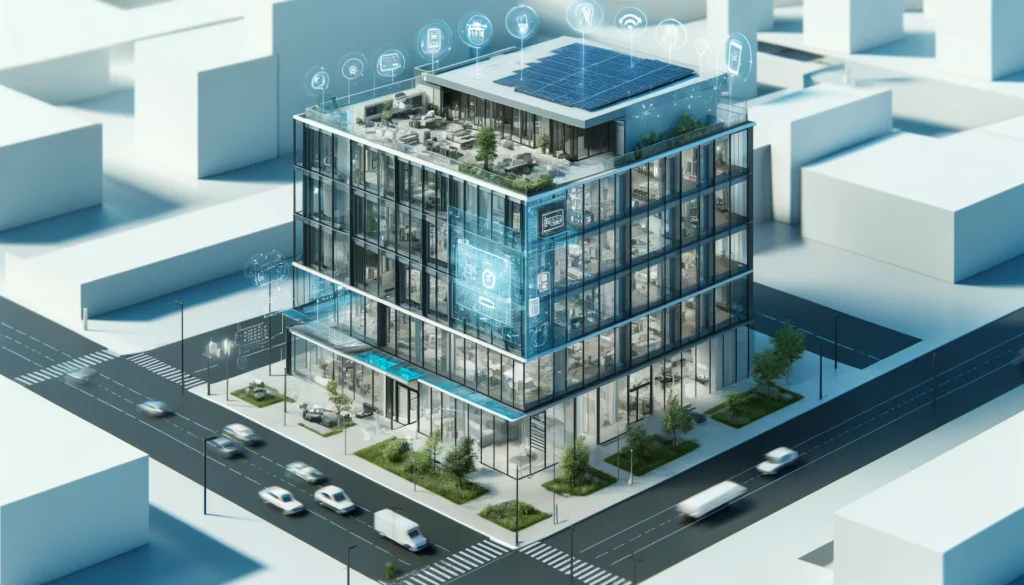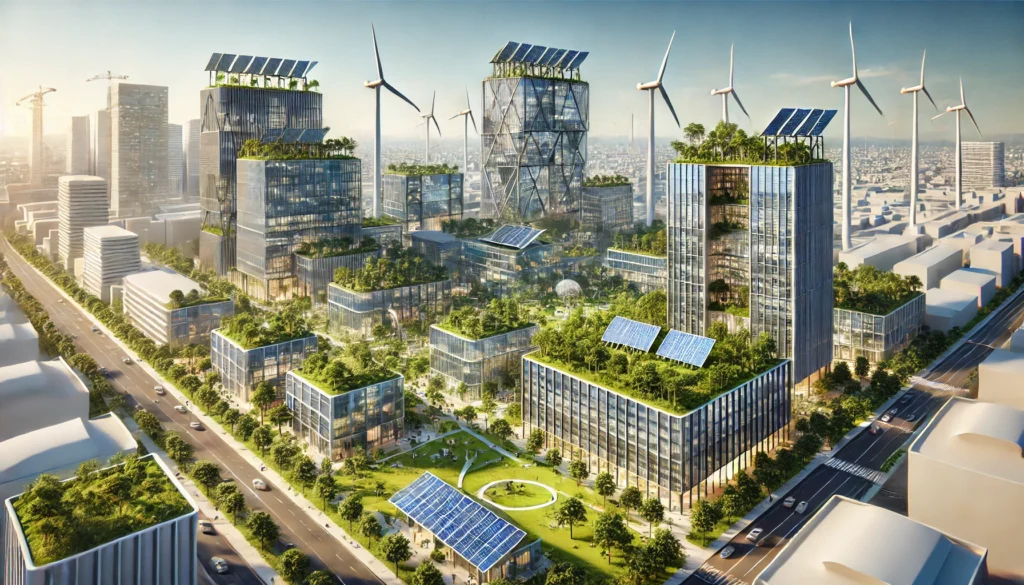Introduction
Smart buildings are transforming the way we design, build, and manage structures. These buildings utilize advanced technologies such as the Internet of Things (IoT), artificial intelligence (AI), and data analytics to enhance efficiency, sustainability, and security. The adoption of smart buildings is increasing globally, driven by a need to optimize energy consumption, improve occupant comfort, and reduce the environmental impact of traditional building systems.
In Malaysia, the adoption of smart building technology is gaining momentum, albeit slower than in some advanced markets. Government policies, economic considerations, and environmental goals are shaping how smart buildings are being integrated into Malaysia’s growing urban landscape.
What is a Smart Building?
A smart building integrates digital systems that interact to monitor, control, and optimize the building’s environment. These systems can include sensors, automation tools, energy management systems, and even AI algorithms that manage HVAC, lighting, and security. The primary objectives are:
- Energy efficiency: Smart buildings can optimize energy use, reducing waste and lowering operational costs.
- Occupant comfort: These technologies offer better climate control, lighting adjustments, and even personalized workspaces.
- Security enhancements: Smart buildings often incorporate biometric security systems, remote monitoring, and automated alerts.
Globally, the smart building market is growing rapidly and is projected to continue its expansion, driven by the increasing need for sustainable development and efficient energy use.
The Adoption of Smart Buildings in Malaysia
In Malaysia, smart buildings are still a relatively new concept but are increasingly becoming a priority in urban planning, particularly in the development of smart cities like Cyberjaya and Iskandar Malaysia. As part of the country’s broader push for digital transformation under the Construction Industry Transformation Plan (CITP) and the National Construction Policy, smart buildings are seen as a key component of future urban landscapes(SMART).
Several key factors are driving the adoption of smart buildings in Malaysia:
- Government Policies and Initiatives: Malaysia has introduced several initiatives aimed at promoting sustainable and smart construction, including the Construction 4.0 Strategic Plan (2021-2025). This plan emphasizes digitalization and smart construction as vital for enhancing productivity and competitiveness in the construction sector. It also stresses the importance of adopting technologies like IoT and AI. Moreover, smart cities such as Cyberjaya are leading the way in integrating smart infrastructure, including buildings that incorporate automated systems for energy management and security(6Wresearch).
- Environmental and Economic Benefits: Malaysia’s push toward sustainability is heavily influenced by the global climate agenda. Smart buildings offer an opportunity to reduce energy consumption significantly through automation and data-driven energy management systems. These technologies allow buildings to minimize their carbon footprint, making them more environmentally friendly and cost-effective in the long term(SMART).
- Energy Efficiency: Energy efficiency is a critical driver for smart building adoption. In a country with high energy consumption, like Malaysia, smart buildings present an opportunity to reduce energy use in commercial and residential buildings alike. The implementation of automated lighting, HVAC systems, and energy meters enables real-time monitoring and adjustments that optimize energy use, reducing waste and operational costs(SpringerLink)(Switch Automation).
- Technology Adoption Challenges: Despite the potential benefits, the adoption of smart building technologies in Malaysia faces several challenges. High initial costs and a lack of technical expertise are barriers that prevent widespread adoption. Moreover, the construction industry in Malaysia is still transitioning from traditional practices to more digitalized approaches. There is also a need for greater awareness and understanding of the long-term benefits that smart buildings can provide in terms of cost savings and sustainability.
Key Technologies in Smart Buildings
- Internet of Things (IoT): IoT devices play a significant role in the functionality of smart buildings. These devices connect various systems—like lighting, HVAC, and security—allowing for real-time monitoring and control. For example, smart thermostats and lighting systems can adjust based on occupancy and external weather conditions(Switch Automation).
- Building Information Modeling (BIM): BIM is increasingly being adopted in Malaysia’s construction industry. This digital model-based technology allows for the planning, design, and management of buildings throughout their lifecycle. BIM is crucial for smart buildings as it enables integration between various digital tools that enhance construction efficiency and post-construction operations(SMART).
- AI and Data Analytics: AI-driven data analytics tools are increasingly being implemented to manage the vast amounts of data generated by smart building systems. These tools help to identify patterns and make predictive adjustments that improve energy efficiency, security, and overall building performance(Switch Automation).
- Sustainability Features: Smart buildings often incorporate renewable energy solutions such as solar panels and energy storage systems. They also use advanced energy management tools to monitor consumption and reduce waste. These sustainability-focused features are crucial in addressing Malaysia’s environmental goals and helping the country meet its commitments under international climate agreements(SMART)(6Wresearch).

Smart Buildings and the Future of Urbanization in Malaysia
As Malaysia continues to urbanize, smart buildings will play an increasingly important role in sustainable development. Cities like Kuala Lumpur are experiencing rapid growth, leading to an increased demand for energy-efficient and technologically advanced buildings. Smart buildings can help address the challenges of urbanization by reducing the environmental impact of new developments and providing healthier, more efficient living and working environments.
Pro Inspect Solution and Smart Building Inspections
One of the key aspects of smart buildings is the ability to monitor and maintain their infrastructure through digital tools and automation. This is where services like those offered by Pro Inspect Solution come into play. The company specializes in property and building inspections, with a focus on structural assessments that are critical for ensuring the longevity and safety of smart buildings. By integrating smart building technologies, Pro Inspect Solution can provide more accurate, real-time data on the condition of a building, helping property owners to identify potential issues before they become serious problems. This proactive approach is crucial in maintaining the safety and efficiency of smart buildings.
Conclusion
The adoption of smart buildings in Malaysia is still in its early stages, but the potential for growth is enormous. Driven by government initiatives, environmental concerns, and technological advancements, Malaysia’s urban landscape is poised for a transformation. However, overcoming the challenges of cost, awareness, and technical expertise will be key to realizing the full benefits of smart buildings.
FAQs on Smart Building
What is meant by smart buildings?
A smart building is a structure that uses automated processes to control the building’s systems such as heating, ventilation, air conditioning (HVAC), lighting, security, and other operational aspects. These systems are connected through IoT devices, sensors, and integrated software platforms that allow for monitoring, management, and optimization of the building’s performance. The goal is to create an environment that is energy-efficient, cost-effective, secure, and comfortable for occupants.
What are the three basic components of a smart building?
The three basic components of a smart building include:
- Building Management Systems (BMS): These are the central systems used to control and manage key building operations like HVAC, lighting, and security.
- Internet of Things (IoT) Devices: These include sensors, actuators, and connected devices that gather and transmit data to automate and optimize building functions.
- Data Analytics and Artificial Intelligence (AI): Data collected from IoT devices is analyzed to optimize building performance, predict maintenance needs, and improve energy efficiency.
What is smart building certification?
Smart building certification is an official recognition that a building meets specific criteria for smart technologies and sustainability. These certifications evaluate how well a building leverages technology to enhance energy efficiency, occupant comfort, and operational performance. Certifications like LEED (Leadership in Energy and Environmental Design), WiredScore, and the SmartScore help establish a building’s credentials as a smart and sustainable facility.
What are the benefits of smart building?
The benefits of smart buildings include:
- Energy Efficiency: Optimizing energy usage by controlling HVAC, lighting, and other systems based on real-time data and occupancy patterns.
- Cost Savings: Reduced energy consumption and predictive maintenance lower operational costs.
- Enhanced Security: Smart systems provide advanced surveillance, access control, and emergency response solutions.
- Occupant Comfort: Improved indoor air quality, lighting, and climate control tailored to individual preferences.
- Sustainability: Reduced carbon footprint through efficient energy management and integration of renewable energy sources.
What is the main goal of a smart building?
The main goal of a smart building is to optimize the performance of the building by improving energy efficiency, enhancing the comfort and productivity of occupants, ensuring safety, and minimizing environmental impact. This is achieved by integrating advanced technologies that allow for real-time monitoring, automation, and control of various building systems.
What makes a building a smart building?
A building becomes a smart building by integrating technology that allows for real-time data collection, analysis, and management. This includes sensors, IoT devices, AI algorithms, and building management systems that are connected to control the operations of the building. A smart building optimizes its energy use, enhances comfort, improves safety, and provides significant operational cost savings by automating its various systems based on data-driven insights.


